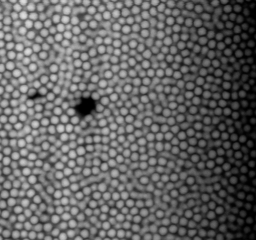 |
We are trying to figure out how a colloidal
glass responds to localized, fast disturbances. To this end we
have placed a very small amount of paramagnetic beads into the large amount
of fluorescent beads which form the colloidal glass. By exposing
these magnetic beads, which are about the same size as the fluorescent
spheres, to a strong magnetic field gradient, we can pull them through
the sample. By rotating the direction of a strong field, we can rotate
a pair of magnetic beads which are stuck together. The image at left shows
the set up for the dimer rotation experiment; a strong permanent magnet hangs
from a computer controlled stepper motor. The poles are oriented horizontally.
The stepper motor rotates the field in the horizontal plane at a controlled
rate.
The effect of the magnetic beads on the sample is unknown. Does
the sample react elastically, flexing under the stress of the moving magbead
and then returning to its original shape after the magnetic field is removed?
Will it simply move along with the bead? How does the distance from
the magbead affect the response of individual beads or groups of beads?
|




